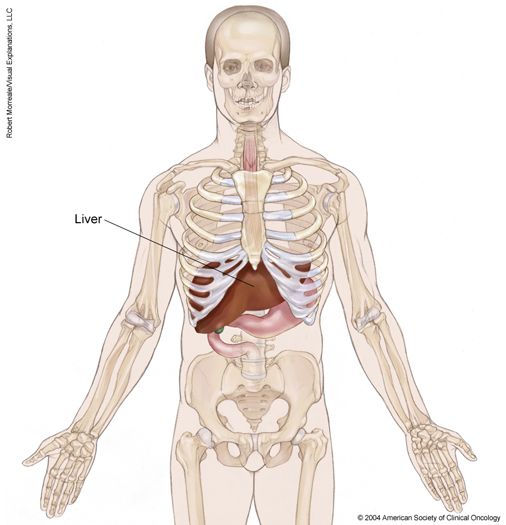Approved by the Cancer.Net Editorial Board, 08/2023
About the liver
The liver is the largest internal organ in the body, and it is essential to live. It plays a key role in the digestion of food and medication. Liver functions include:
- Collecting and filtering blood from the intestines
- Processing and storing needed nutrients absorbed by the intestines
- Converting some nutrients into energy or into substances needed to repair and build tissue
- Producing some of the body’s blood-clotting factors
- Removing toxins from the body
- Helping maintain the proper sugar level in the body

About liver cancer
Cancer begins when healthy cells change and grow out of control, forming a mass called a tumor. A tumor can be cancerous or benign. A cancerous tumor is malignant, meaning it can grow and spread to other parts of the body. A benign tumor means the tumor can grow but will not spread.
This section only provides information about cancer that begins in the liver. This is known as primary liver cancer.
It is more common for cancer that started in another part of the body to spread to the liver. This is called metastatic cancer. Cancer that has spread to the liver from another part of the body is not liver cancer. Rather, it is based on where the cancer started. For instance, pancreatic, colon, stomach, breast, lung, or another type of cancer that has spread to the liver is still named according to the organ in which it started. This is important to note, as primary liver cancer is treated differently than metastatic cancer that started elsewhere and then spread to the liver. For more information about cancer that started in another part of the body and has spread to the liver, read about that specific cancer type.
Types of primary liver cancer in adults
There are several types of primary liver cancer that occur in adults. They are named for the type of cell from which the cancer develops.
| Type of Liver Cancer | Description | How Common |
|---|---|---|
| Hepatocellular carcinoma (HCC) | Hepatocellular carcinoma can have different growth patterns. Some spread tentacle-like growths through the liver. This pattern is the most common one in the United States. Some start as a single tumor that spreads to other parts of the liver as the disease develops. Others develop as nodules at several different places in the liver. Occasionally, a pattern isn’t clear. | Approximately 73% of primary liver cancers in adults are hepatocellular carcinomas. |
| Cholangiocarcinoma, also called bile duct cancer | A cholangiocarcinoma develops from cells in the bile duct of the liver. The bile duct is a thin tube that extends from the liver to the small intestine. The bile duct starts inside the liver as several smaller tubes that join together. | About 18% of primary liver cancers in adults are cholangiocarcinomas. |
| Angiosarcoma | Angiosarcoma starts in the blood vessels of the liver and grows very quickly. | About 1% of primary liver cancers in adults are angiosarcomas. |
The rest of this section provides information on the most common type of adult primary liver cancer, hepatocellular carcinoma (HCC). For information about bile duct cancer and angiosarcoma, use the links in the chart above.